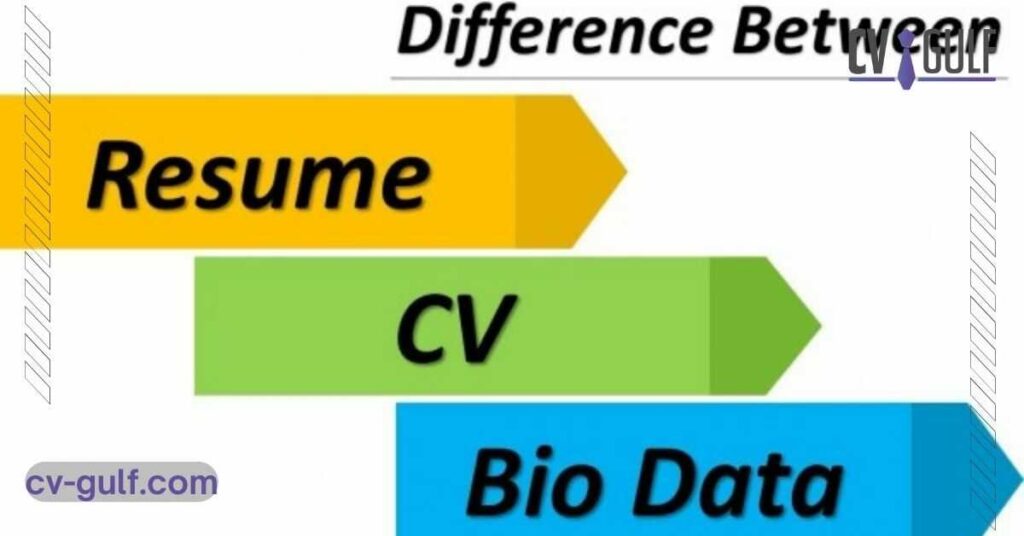Biography CV vs. CV bio: all you should know
آخر تحديث: 25 April، 2024
المقال السابق: Resume format for Gulf countries pdf

Knowing what information to include in a biography can be a helpful first step when writing about someone – either yourself or someone else. You can follow some guidelines to determine what to include in a biography when a person’s life is filled with rich details and interesting facts.
Here, we will discuss the short CV bio, which is a part of your CV, and the more extended biography (biography CV), which has several uses.
What is a bio for a cv?

The bio for the cv aims to provide a short summary (3–6 lines) of the candidate’s expertise, strengths, and skills, which will act as the starting point for the interview process.
Moreover, the CV bio must provide pertinent information about the candidate’s education, experience, projects with which he or she has been involved, and the systems and applications they are proficient.
Before reading the candidate’s CV, a hiring manager can determine whether or not he or she is suitable for the role by reading this small but compelling introduction. Next, I will discuss how to write a short bio for your CV and explain the long biography cv later.
How To Write a Professional CV bio in 6 Steps?

Here are some tips on how to make your CV bio more professional.
Identify your title and name in the CV bio.
You should always start by choosing an appropriate name and professional title for your professional bio before writing it. Different headers and terms may be relevant depending on the purpose and audience of the biography. For example, some people use their given name in their bio rather than the first name they were delivered on their birth certificate.
A professional may also use a different surname after marriage instead of the one they originally had. The titles you hold on your resumes, such as MD (medical doctor) or Esq (esquire), may also need to be included or omitted if you have any of those.
Choose a style for your CV bio.
A bio should be written in a way that reflects your personality. You must include your name in your bio, regardless of whether you refer to yourself in the first person or the third person; you should be specific about who you are.
The most common method of putting together professional bios is to write them in the third person. The most widespread way of putting together personal memoirs is to write them in the first person. Ask your manager or editor to help you choose the most appropriate bio form if you’re writing one for work.
Include your tagline or position in your CV bio.
The following advise you to list the name of your current employer when preparing your bio. You should say “Senior Associate” or “Editor” if employed. If you are unemployed, when creating a biography for a CV, you should list your previous role or your current expertise.
Include your current employer in the CV bio.
Identifying your current employer can help your audience better understand what you’ve been doing in your field. This will help them to understand whether or not you’re available to work at the moment.
Identifying your position, title, or role is necessary before specifying your employer. Self-employed individuals or those without a current employer can skip this step.
Make a plan for your CV biography.
You would then need to know what work philosophy or life philosophy you hold dear and how it influences how you achieve success. This topic could be included in your bio to explain what motivates you to the audience and why you do what you do. Is developing strong relationships vital to you?
Include fun or personal detail in the CV bio.
Demonstrating a well-rounded individual might sometimes be helpful in some situations. However, In bios, the following are some examples of what is popular:
- Personal interests.
- Reading, watching, or listening preferences.
- Life-related information for families.
- Claims or habits that are humorous.
Now let’s dig into the long biography cv.
What is a professional biography?

- Your professional biography is an overview of your professional skillset through your education, experience, and education. The purpose of what you do, and your impact (what you wish to accomplish for your patients/clients, organization, and/or in the world), should also be included in your bio.
- Additionally, it is a great way to promote your brand as a professional and compellingly tell your story. The purpose and audience of your professional biography should be tailored according to the purpose and audience of your resume.
- Instead of a resume, you might want to write a biography CV including a professional photo (headshot) and talk more about your hobbies, interests, and family life. You can demonstrate who you are beyond your work environment if you do this well.
- The length of a professional biography should be tailored to the setting in which it will be used. To write shorter versions of your biography, it is wise to start with your long biography.
- Extended biographies serve as longer introductions to professionals. As an author bio, an introduction for speakers or presenters, or a description of a board director or leadership team in an organization, long bios are used for various purposes.
- There are usually 3-5 paragraphs in a long bio, with each section containing 3-5 sentences. The short biography is typically used in other publications as author bios at the end of articles or blog posts, in the “About” section of a company or personal website, or in a business directory.
- The professional summary statement can also be used on social media accounts. There are generally one or two paragraphs in a short bio, each consisting of 2-4 sentences. A pitch is a brief summary of your professional experience and qualifications, typically no longer than 2-4 sentences. Creating this formula is as easy as presenting the past, then predicting the future.
How do you write a biography?

It is not necessary to include all of these elements in every biography CV. Consider the person’s story and the purpose for which the memoir is created to determine what makes the most sense. To write a biography, use that information as a guide. Start With Basic Facts About the Person.
Considering the length of the biography will help you determine how much or how little information should be included, as well as how in-depth that information should be. Just a few general facts, such as those listed below, will make up a simple paragraph:
- Birth and death dates (if applicable).
- Residence at present.
- Background in education.
- Experience in the field.
- Specialties.
- Achievements of note.
Incorporate more detailed information.
- Give your readers historical context by providing details about someone’s birth and childhood. You might mention the type of environment the person grew up in when writing about a civil rights activist from the 1960s.
- The biography of a person’s adult life will probably focus most on the significant events that occurred during their adult life. You may want to pay attention to significant life events such as the start of a relationship, a drastic life change, or some other central turning point.
- You’ll probably want to include the events before the deceased passed in your story. Can you tell me what legacy they left behind?
- Facts or anecdotes that tell the story of the person’s life – Select points or accounts that are engaging to readers or particularly relevant to the biography cv.
- Consider including a few quotes about the person that illustrate what others have said about the person in articles, books, and news stories.
- Including a person’s photo before a presentation is essential if the bio will be distributed via print, published online, or highlighted in a PowerPoint.
Biographies become more involved as you write them, so you will face questions about what to include and how to present the information. Remember why you find this person attractive and who might be interested enough to read the biography cv.
You must then write a biography that informs your audience about your subject by focusing on the facts that will be the most important to them.
Creating content for an unknown audience.
Trying to determine who your audience is can be tricky – if you were to write a book, for example, it would be impossible to know who would read it. Those interested in the biography will likely read it since it is about the person they are interested in.
- If this is the case, you should focus your research on what makes the person unique.
- An account of someone’s educational background and early experiments that led to a remarkable discovery may be the focus of a biography.
- Moreover, it can also discuss how the discovery has affected the researcher’s life, the lives of others, or the field or profession of study of the researcher.
Tips about biography.
Biographies can be challenging but can also be enjoyable when written well. Here are some quick tips for writing a successful biography.
Your career story has more latitude to show your personality and creativity, even though you want to be professional. The following tips should be kept in mind when writing your biography.
- You should always write it in the third person. When writing a brief introduction, it may be acceptable to use the first person, but generally, a third person reads better.
- Be ruthless when it comes to proofreading and editing. Check your work for clarity, compelling content, and typos and grammatical errors with your trusted colleagues.
- Include your contact information and any relevant brand nicknames you might be known by
- Including relevant links to your work is a must.
- Lastly, it is essential to think about your overall reputation and brand online. Write conversationally, avoid jargon, and update regularly. Make sure the information you use reflects the professional image you want to project by conducting a search to see what appears.
What is the difference between a biography CV and a resume?

You can write each CV, resume, and biography differently depending on the requirements and understand their practical applications by understanding the differences between them. As we talked about biography previously, It is possible to differentiate between a CV and a resume in a variety of ways:
- There is a tendency for CVs to be more detailed than resumes. This document provides a comprehensive overview of the life and career of the candidate, as well as information about the candidate’s educational background.
- An individual’s resume is much like a summary of their career history instead of an overview.
- Typically, CVs are between two and four pages long, but they can sometimes be There is no restriction on how many pages a resume can be. Compiling a biodata for a candidate is usually over two pages long.
- An updated CV includes your qualifications and skills and the opportunity to customize the CV for a larger audience.
- There should only be certifications that are relevant to the job and are active on the resume. You can customize your biodata according to what you are looking for.
Q&A:
You must never forget that, whether you are writing a biography of yourself or something else, one of the essential things is to be able to tell the true story of the person you are writing about. Information that you provide should only be factual, and it should be presented engagingly.
Our free CV builder can help you with your CV, so choose a free professional template that suits you best! You can also request a free expert review or go premium to get VIP assistance. Contact our office in Jeddah via WhatsApp. Click here.
Learn more by reading How to make a professional CV, What is the best Gulf CV format, and Guideline | CV format for job in Saudi Arabia.